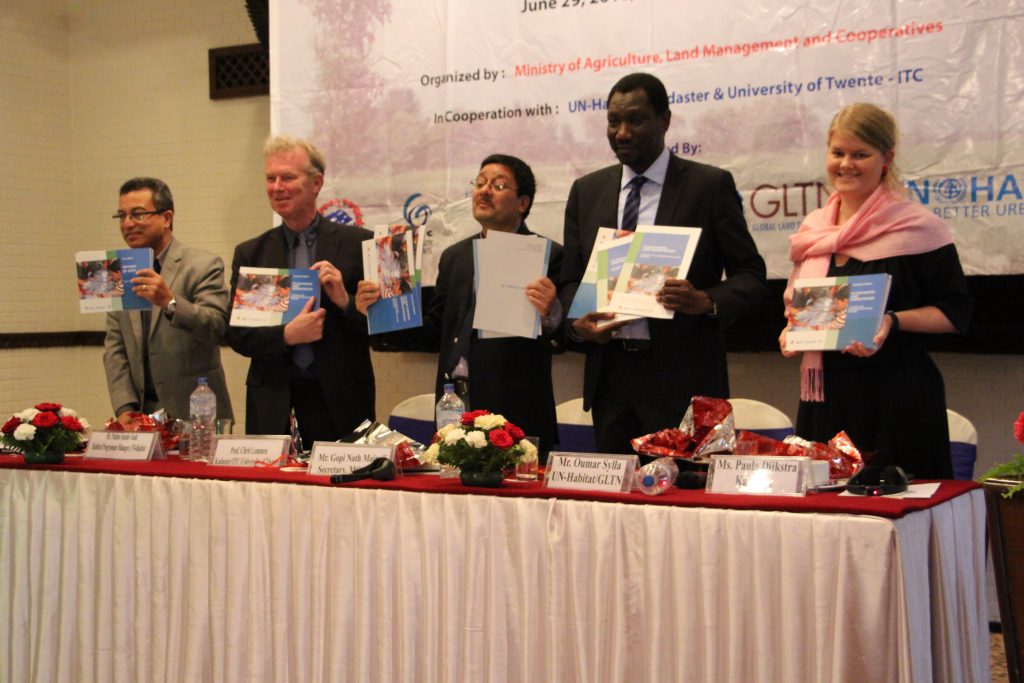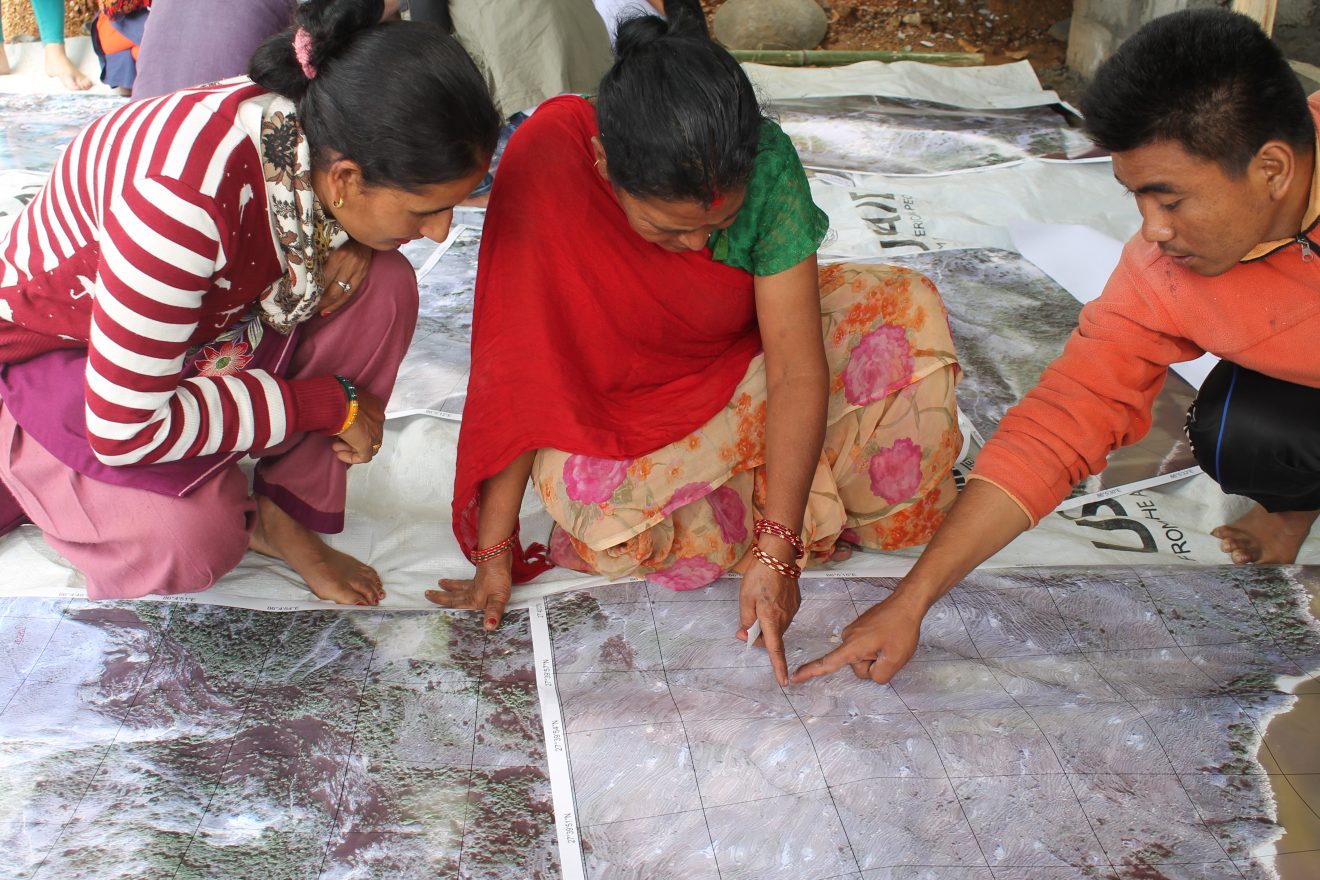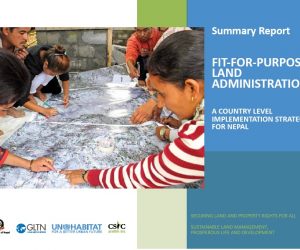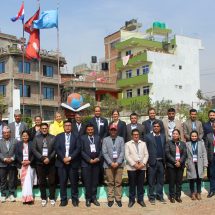Secretary Gopi Nath Mainali of the Nepal’s Ministry of Agriculture, Land Management and Cooperatives (MoALMC) formally launched the newly adopted ‘Fit-For-Purpose Land Administration – A Country Level Implementation Strategy for Nepal’ as witnessed by representatives from UN-Habitat, GLTN Secretariat, Kadaster International, government authorities, civil society organizations and other land stakeholders in Kathmandu, 29 June 2018. Secretary Mainali, in his foreword of the publication, further emphasizes that the “Ministry will consider, as per requirements, the findings, conclusions and recommendations provided to implement land policy and in its persuasion for good land governance in the country”.
The Fit-For-Purpose Land Administration document dwells extensively on the existing land and tenure issues and the strengths and weaknesses of the current land administration system and proposes different initiatives for reforms in the spatial, institutional and legal frameworks. The application of visual boundary method for identification, verification and recording of non-formal and informal properties, participatory mapping under the supervision of official Surveyors and adoption of alternate dispute resolution mechanisms are highlighted. Also, the new legal provisions favoring the adoption of Fit-For-Purpose Land Administration is recommended to be in place as soon as possible.
After a decade long (1996 – 2006) armed conflict in Nepal, peace process came to a fruitful culmination through the adoption of a new Constitution in 2015. Equitable access to land and security of tenure were among the major triggers of conflict and promised to be addressed in favor of landless, economically and socially vulnerable and women in the new Constitution. Although Nepal has in place a land administration system with most of the cultivable lands registered in the national cadastre, estimates show that some 25% cultivable lands consisting of some 10 million parcels are still under non-formal and informal tenures.

Some 120,000 tenants are legally registered and possess legal rights on 50% of the land they cultivate but as land rights advocates claim there are more than 500,000 unregistered tenants legally unrecognized and without security of tenure[1]. The informal tenure-holders and such unregistered tenants are among the economically and socially most vulnerable and face constant fear of forced eviction. To address these issues, the Government of Nepal has worked out a National Land Policy with a vision of “Sustainable Land Management, Prosperous Life and Development” and an important policy enunciation – “Security of tenure, protection of land ownership and security of land and property rights for all”.
With the adoption of federal governance setup, land administration will now be delegated to the 753 municipal government tiers. To address this complexity, conventional approaches to land survey, registry and land administration should be reviewed in its entirety to make them more responsive, efficient and effective. With the Global Land Tool Network’s (GLTN) technical and financial support, Nepal is heading towards the adoption of Fit-For-Purpose Land Administration approach. The initiative for developing Fit-For-Purpose Land Administration Country Level Implementation Strategy is led by MoALMC and locally supported by UN-Habitat Country Office and a local NGO, Community Self Reliance Centre (CSRC). The methodology adopted is a three-phase process- identification of all types of locally existing land tenure typology; land policy revision to address security of tenure, protection of land ownership and security of land rights for all; and developing a Country Implementation Strategy based on Fit-For-Purpose approaches. The strategy development process has benefited also from the inputs of Prof. Stig Enemark, a well known international land administration expert and the main author of the GLTN’s publication entitled Fit-For-Purpose Land Administration: Guiding Principles for Country Implementation.
Land surveyors, land registry officials and other land stakeholders alike are adapted to conventional land administration approaches. As such, capacity development at all levels is important. GLTN, together with UN-Habitat Country Office, government authorities and their partners like ITC-University of Twente, Kadaster International and other local land institutions are also engaged in piloting fit-for-purpose land administration approaches and currently organizing various capacity development initiatives at different levels. More sensitization and engagements with the provincial and the local municipal governments levels in advocacy, capacity development and support in developing legislations and guidelines are the next steps towards the adoption of the Fit-For-Purpose Land Administration approaches in the country.
[1] Jagannath Adhikari says “As of 1995, there were 0.45 million tenants, who had not been given their tenancy rights” (Source http://www.actionaid.org/sites/files/actionaid/land_reform_complete_-_done.pdf )














